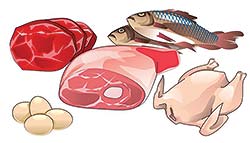What is Taurine:
Taurine is an amino acid that is naturally found in the dog’s body. Amino acids act as the building block for body proteins. They also play a vital part in managing bodily functions. For humans, there are more than 20 amino acids in the body that make up proteins. However, for all species, there are two categories of amino acids - Essential amino acids & Non-essential amino acids.
The body produces non-essential amino acids on its own; hence the name. However, essential amino acids are not produced naturally. Such amino acids are either taken through supplements or are added to the diet.
Taurine is a conditional essential amino acid for humans and a non-essential amino acid for dogs. In dogs, methionine and cysteine, are the two amino acids that produce taurine for their system.
However, some dogs are incapable of producing taurine on their own. In such cases, taurine is either added through a specialized diet or supplementation. Most animal proteins are perfect ingredients to add to the diet. Not only are they rich in taurine, but they can also balance the nutritional intake. Most commercial dog foods add Taurine to the diet by either supplements or using ingredients that are high in the amino acid.

Amino acids are quite essential for the body to operate smoothly. If these acids are not found in recommended doses, their deficiency causes diseases which can lead to a few painful conditions. The eyes, brain, heart, and bloodstream of dogs carry taurine in abundance. So, these bodily organs are the first to show symptoms in case of a deficiency.
It’s recommended that small dogs get at least 250mg per day and large dogs get up to 1000mg per day.
We know amino acids are essential, but what is the best way to get it?
Food sources:
Any food that uses high quality proteins will provide a higher quantity and quality of Taurine. Whole meat listed as the first ingredient is a good indicator of quality. But kibble is cooked and extruded at high heats so no matter how high a quality of protein is used, fresh food sources are always superior to cooked and heated options.
Lightly cooked or Raw food options that contain Fresh meat, heart and liver are the best sources of naturally occurring Taurine. When a food is whole or unprocessed (heated) it is far more bioavailable. It can be absorbed by the digestive tract easily. Many kibble companies know this fact and add Taurine supplements after the food has been cooked by adding it the coating sprayed on all kibble just before it hits the bag. They also use ingredients like Brewer’s Yeast and Egg products because both contain a superior levels of Taurine or, methionine and cysteine that can be converted by the body to Taurine.
Liver is a concentrated source of Taurine as it’s a filter organ and contains the highest levels of Taurine from many common animals used for pet food. Chicken and Turkey liver have higher levels than Beef and Lamb. This is due to the fact they have smaller more concentrated organs. Hearts also have a high amount of Taurine as they require the amino acid to function themselves. Many Food companies use organ meat to provide the needed levels this amino acid. If these organs are fresh, frozen, or Freeze dried this will provide the highest amount of Taurine that is the most bioavailable for your pet.
Fish and Shellfish also have high amounts of Taurine in them. The smaller the fish or shellfish the higher the concentration of Taurine. Fish like mackerel, Sardines and Capelin are easily available for pets in pet food and can provide an excellent source. Shellfish like Mussels, and clams also have high naturally occurring Taurine and can easily be found in freeze dried forms to be added to the diet. Fish and shellfish also have other benefits of naturally occurring glucosamine in them as well and can be an excellent choice of food additive for senior dogs with achy joints.
Eggs are also an excellent source of Taurine as well as Lysine both quality amino acids that are beneficial to dogs. Raw vs boiled does not matter as the amino acid degrades very little with boiling. One egg contains 350mgs of Taurine.
Synthetic Supplements:
These are a convenient and consistent way to ensure your dog gets enough Taurine. Synthetic supplements (pills and some powders) need to be taken in higher does to ensure absorption and often come in 1000mg doses or higher. Many companies use Chinese based sources, and test for quality in USA labs but Human grade or certified products are a must in this instance.
To summarize Taurine and its importance in your pets diet we recommend feeding foods that use high quality meats listed first on the ingredient list. Fish, Chicken and Turkey have more Taurine than lamb and beef. Organ meats like liver and hearts, brewers’ yeast and eggs are all good ingredients for Taurine and should be listed as high up as possible. Supplementing with fresh food ingredients high in Taurine is superior to giving pills or powder.
Dog-Friendly Walks/Hikes
in the Moab Area |
Corona Arch - Easy/Moderate. 1.3 Miles one way. Trailhead is 25 minute drive from Moab. North on US-191 to Potash Road (Utah 279).
Mill Creek Pathway - Easy. 1.1 Miles. Little to no driving. Starts at the intersection of 100 South and 100 West, a block off of Main Street.
Portal Overlook - Hard. 2.0 Miles one way. Trailhead is 20 minute drive from Moab. N. on US-191 to Potash Road (Utah 279).
Grandstaff Canyon - Moderate. 2.0 Miles one way. Trailhead is 10-minute drive from Moab. North on US-191 to the River Road (Utah 128) |
|